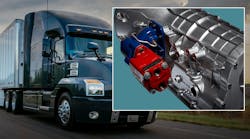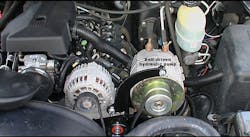A power takeoff (PTO) provides an efficient means of driving a hydraulic without consuming under-hood space. Image courtesy of Muncie Power Products.
Another common error is simply relying on what’s been done historically. Technology continues to advance; new options are constantly hitting the market. It is important to examine all advantages of new product offerings rather than assume the traditional option is, in fact, the best solution. Taking the time to analyze work environments, challenges, and actual demands positions you, as a fleet professional, to make the right choice.
Real-World Perspective
It may prove helpful to consider a practical application. For example, external power export solutions have come a long way from a stand-alone gas or drive a shaft-drivengenerator. Power management may be partially integrated into an existing truck design. A hydraulic generator is one answer; the concept is similar to the gasoline-powered stand-alone counterpart, but it’s more compact and versatile. These generators can be specified or retrofitted into existing work trucks with hydraulic circuits.
Without the gasoline power plant, size and weight can be reduced by 50%. In terms of maintenance costs, there are no gasoline engines to support and fewer environmental factors. Considering these dynamics demonstrates the importance of looking at the big picture and evaluating alternative solutions to minimize additional auxiliary equipment needs, maintenance issues, andoperating costs.
Christopher Lyon is Director of Fleet Relations at NTEA–The Association for the Work Truck Industry, Farmington Hills, Mich. Established in 1964, NTEA represents more than 2,050 companies that manufacture, distribute, install, sell and repair commercial trucks, truck bodies, truck equipment, trailers, andaccessories. Headquartered in Farmington Hills, Mich, and government relations offices in Washington, DC, and Ottawa, Ontario NTEA produces The Work Truck Show®.




